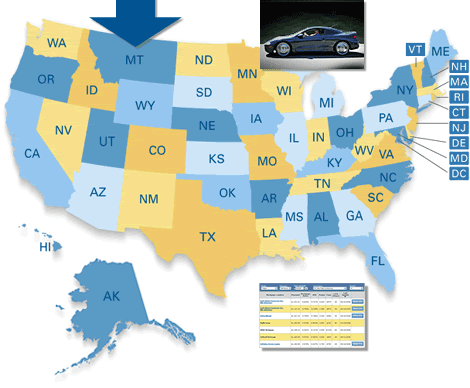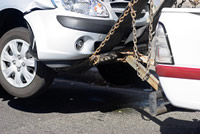Tips on Reducing Your Auto Insurance Expenses
by Amy Lillard
• Paying a higher deductible will help decrease your premium substantially, therefore you should select the highest deductible you can afford. Also if you have a minor accident and can shoulder the cost of the repairs on your own without filing a claim, but simply reporting the incident to the insurance company, you may find yourself rewarded by your insurance carrier.

• Eliminate any unneeded coverage on older vehicles. You may be able to drop all but the liability coverage if the value of the vehicle is low enough (i.e. just a few thousand dollars) and there are no outstanding loans remaining on the vehicle.
• Maintain a clean driving record so you can qualify for as many discounts as possible. Safe driver discounts and multiple policy discounts are within your control so take advantage of both. Average miles driven along with length of office commute can also factor into any discounts offered. Safety or defensive driving classes taken on a voluntary basis, along with maintaining membership in such organizations as AAA, may also result in discounts.
• Drive a vehicle that is less costly to insure. The safety features on a vehicle can factor in big if you have chosen a vehicle which performs well in an accident. Features such as anti-theft devices, airbags and anti-lock brake systems can help reduce costs. Obviously sports cars with high performance engines are more costly to insure as are classic cars and vehicles that are on “hot lists” which are frequently targeted by auto thieves. Note in some cities tire theft has become the latest trend in auto theft, they leave the vehicle behind but strip the tires.
• Be sure you have sufficient coverage. Be certain you have adequate coverage to protect your personal assets in the event of a lawsuit. The additional coverage is relatively inexpensive relative to the potential risk involved. Don't be cheap in this area and later regret leaving yourself unnecessarily exposed.
• Choose an insurance company has a high industry rating. The policy itself may be standard but the way a company handles its customers, along with its claims process, could vary considerably from one carrier to another. This may be the time to remember the adage “you get what you pay for”. Selecting the carrier with the lowest premium quoted may be a decision you later regret.
 A frequent contributor to ERATE® since 2006, Amy Lillard is a freelance writer specializing in turning complex information into useful tips and tricks for readers. For questions or topic suggestions, contact Amy at [email protected].
A frequent contributor to ERATE® since 2006, Amy Lillard is a freelance writer specializing in turning complex information into useful tips and tricks for readers. For questions or topic suggestions, contact Amy at [email protected].
New and Used Auto Loan Rates
Choose Your State Below

Start by selecting your state
Other related articles:
Car Insurance Quotes: Discovering the Best Deals
Auto Loans Advice: New Cars & Used Cars
Research your options when shopping for an auto loan
Car Buying vs Car Leasing

Life Insurance
- Term, Whole, Universal, Varialble Life Insurance
- Guidelines for Purchasing Life Insurance
- Life Insurance: Finding the Best Rates
- Life Insurance Explained: Types and Coverage

Medical Insurance
- Health Insurance Basics
- Healthcare Costs and Retirement
- Critical Flaws in HealthCare
- Disability Insurance
- Tips on Buying Long Term Care Insurance
General Insurance Articles

Homeowners Insurance
- Homeowners Insurance Premiums Policy
- Homeowners Insurance: Filing a Claim
- Punxsutawney Phil's forecast-homeowners insurance rates
- Homeowners Insurance Costly Trends
- Home Insurance Costs on the Rise, Coverage Options Decrease
- Homeowners Insurance: The Special Policy for Condo Owners
- Homeowners Insurance College Students Coverage
- Underinsured Homeowners
- Beyond Homeowners Insurance: Coverage for Renters
- What Home Owners Insurance Do You Need? Tips for the Best
- Home Insurance Quotes: Types of Home Owners Insurance
- Home Insurance: How are Insurance Quotes Determined?
- Homeowners Insurance: Finding the Best Quotes


Auto Insurance

- Hitting the brakes on auto insurance costs
- Car Insurance Quotes: Discovering best deals
- Car Ins Quotes: What Factors Determine Rates
- Auto Insurance Quotes and Policies: Commonly Used Terms
- Shopping Prep: What You'll Need to Obtain Car Insurance Quotes
- Auto Insurance Terms & Descriptions
- Understanding Your Auto Insurance Quotes: The 7 Types of Car Insurance
- Auto Insurance - Best Plan for You
- How much Car Insurance to buy
- Need to Know Auto Ins Policy
- Automobile Insurance Settlement Advice
- Managing Auto Insurance: What to Do After an Accident
- Filing a Car Insurance Claim: Steps to Follow after an Accident
- Auto Insurance Steps to Filing a Claim
- Tips - Reducing your Auto Insurance Expenses
- Driving a Hard Bargain
- Slow Down Drive Safely
- Cheapest & Most Expensive Vehicles to Insure
